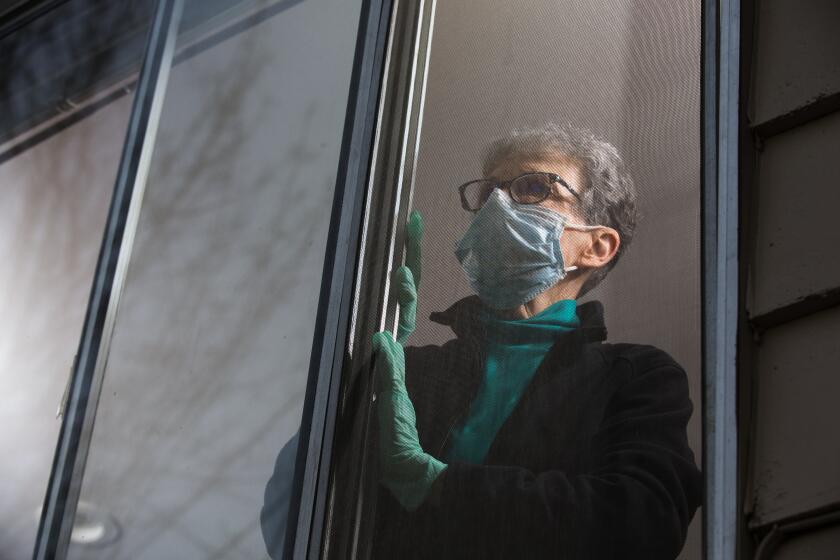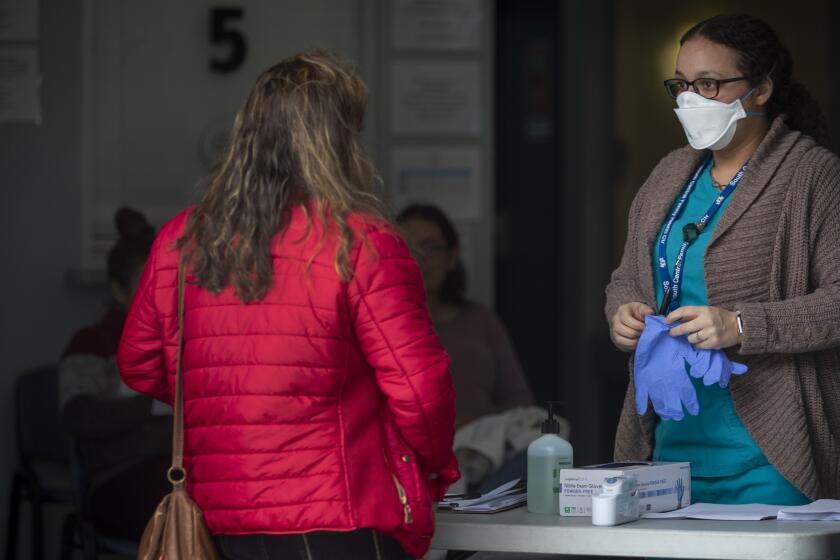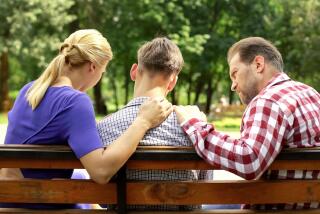Signs of depression have tripled in the U.S. since the COVID-19 pandemic got underway
- Share via
The COVID-19 pandemic has touched pretty much every person in America — and it shows in the state of our mental health.
The prevalence of sleep troubles, lethargy, feelings of hopelessness and other depression symptoms in adults across the country has more than tripled since the pandemic began, according to a new study.
In the weeks after the outbreak prompted quarantines and stay-at-home orders, 27.8% of those surveyed had at least one symptom of depression. That compares to just 8.5% of people in 2017 and 2018.
And it’s not just that the proportion of people experiencing signs of depression had increased by mid-April — the burden of those symptoms increased as well. After the pandemic caused a radical shift in daily life, there were “fewer people with no symptoms and more people with more symptoms,” researchers wrote this week in the journal JAMA Network Open.
“These findings serve to alert our attention to yet another impending public health crisis as a result of this pandemic — the increase in cases of major depression,” Dr. Ruth Shim, an expert on cultural psychology at UC Davis, wrote in a commentary that accompanies the report.
The team, led by a group from Boston University’s School of Public Health, had good reason to suspect the pandemic would take a toll on mental health. Previous studies have documented upticks in depression, post-traumatic stress disorder and other mental illnesses in the wake of traumatic events.
For instance, after the attacks of Sept. 11, 2001, researchers found that nearly 10% of Manhattanites had symptoms of depression and 7.5% had signs of PTSD, with the highest risk seen in people who lived closest to Ground Zero, a study in the New England Journal of Medicine reported. Another study in the journal Molecular Psychiatry found that the prevalence of PTSD, suicidal ideation and other signs of mental illness increased among people affected by Hurricane Katrina in the months after the storm, and kept rising for at least a year after that.
Disease outbreaks can be traumatic events too. A survey of Toronto residents forced to quarantine due to the 2003 SARS outbreak revealed that 31% had symptoms of depression and 29% had signs of PTSD. And in 2015, during the Ebola epidemic, nearly half of the people living in Sierra Leone had at least one sign of anxiety or depression, and more than three-quarters had a symptoms of PTSD.
Although America’s COVID-19 case count was about 600,000 in mid-April and the death toll was around 23,000, the coronavirus had made itself felt almost everywhere. At that time, at least 96% of U.S. residents were being asked — or required — to stay at home, and more than 20 million people had lost their jobs.
As the coronavirus keeps us stuck at home, scientists and health officials fear that social distancing could take a toll on our mental health.
To assess the country’s mental state, the Boston University investigators and their colleagues collected surveys from 1,441 people who were part of the AmeriSpeak research panel run by the University of Chicago. The surveys — which were sent out between March 31 and April 13 — included a widely used mental health assessment that asked about a range of symptoms, from loss of appetite to “thoughts that you would be better off dead.”
Participants were also asked about their exposure to COVID-19 and stresses related to the pandemic. General demographic questions about age, sex, race and ethnicity, income and the like were included on the surveys as well.
The measure of America’s baseline mental health came from a different group of 5,065 people who participated in the Centers for Disease Control and Prevention’s National Health and Nutrition Examination Survey in 2017 and 2018. Overall, the NHANES participants had higher household incomes than their AmeriSpeak counterparts; otherwise, the demographic characteristics of the two groups were closely matched.
Across the board, symptoms of depression were more common in the COVID-19 era than in 2017 and 2018. For instance:
• The percentage of men who reported at least one such symptom rose from 6.9% to 21.9%, and for women it increased from 10.1% to 33.3%.
• Before the pandemic, 8.4% of Black, white and Latino Americans had at least one symptom of depression. During the pandemic, those figures rose to 24.2%, 26.5% and 34%, respectively. Meanwhile, the percentage of Asian Americans with at least one symptom rose from 4.4% to 23.1%.
• In 2020, 38.8% of U.S. adults ages 18 to 39 had at least one symptom of depression, up from 9% in the earlier years. That increase was mirrored among Americans in their 40s and 50s (jumping from 8.5% to 26.8%) and those 60 and above (rising from 7.9% to 14.9%).
• Among Americans with a college degree, the odds of having one or more depression symptoms rose from 4.7% before the pandemic to 18.3% in the outbreak’s early days. Likewise, for Americans with only a high school diploma, they rose from 9.3% to 35%.
It’s not just that more people have signs of depression, but that their symptoms have become more serious. In the age of COVID-19, the prevalence of “moderate” depression symptoms was 2.6 times higher than in 2017 and 2018, and the prevalence of “severe” symptoms was 7.5 times higher. That last statistic is particularly concerning because severe depression is linked with suicide risk and requires intensive treatment to overcome, Shim wrote.
The incidence of injuries attributed to domestic partner violence rose sharply after the coronavirus outbreak began, and those injuries were more serious.
The researchers asked people in the AmeriSpeaks group about 13 specific types of stressors related to COVID-19, including losing a job as a result of the pandemic or losing a loved one to the disease. They found that among Americans with a “low” COVID-19 stressor score, 15.5% had at least one depression symptom, as did 25.1% of those with a “medium” stressor score and 42.9% of those with a “high” stressor score.
After controlling for demographic differences, the researchers calculated that people with high levels of COVID-19 stressors were three times more likely to experience symptoms of depression than people with low levels of stressors.
The study authors noted several shortcomings of their work. Although both groups of people were representative of U.S. adults as a whole, the ideal study would have interviewed the same people before and after the pandemic began. In addition, the questionnaire used to gauge symptoms of depression is a validated method to screen for the condition, but it’s not as precise as a medical diagnosis from a clinician.
Despite these imperfections, the takeaway was clear: The deadly pandemic and its economic consequences have been accompanied by an unprecedented increase in mental illness in the United States, the researchers wrote. And it could continue to rise as the outbreak drags on.
“We imagine that as the virus spreads and more cases of COVID-19 are confirmed, so too may mental illness increase among those with COVID-19 and those around them,” the study authors concluded. “This burden is being borne by economically and socially marginalized groups, suggesting that individuals with low income and with fewer resources may benefit from particular policy attention in coming months.”
Shim offered some specifics: an extension of unemployment benefits, protections for renters, better access to healthy foods and a concerted effort to “end discrimination and exclusion.”
Unfortunately, she added, “there is little evidence that preparation for the mental health implications of COVID-19 are under way.”









